Identification of Multiple Local Damage to an Offshore Jacket Substructure Using a Novel Strain Expansion–Reduction Approach
Abstract
1. Introduction
2. Methods
2.1. Theory of the SER Approach
2.2. Damage Identification Approach
2.3. Damage Index
2.4. Validation Model
2.4.1. Numerical Model
2.4.2. Experimental Setup
2.4.3. Model for Multiple Damage Site Identification and Damage Scenarios
3. Results and Discussion
3.1. Validation
3.1.1. Numerical Results
3.1.2. Experimental Results
3.1.3. Discussion
3.2. Identification of Multiple Instances of Damage for an OWT Substructure
3.3. Dominant Loading Analysis for Future Application of the SER Approach
4. Conclusions
Author Contributions
Funding
Conflicts of Interest
References
- Farrar, C.R.; Worden, K. An introduction to structural health monitoring. Philos. Trans. R. Soc. A 2007, 365, 303–315. [Google Scholar] [CrossRef] [PubMed]
- Cawley, P.; Adams, R.D. The location of defects in structures from measurements of natural frequencies. J. Strain Anal. Eng. Design 1979, 14, 49–57. [Google Scholar] [CrossRef]
- Brownjohn, J.M. Structural health monitoring of civil infrastructure. Philos. Trans. R. Soc. A 2007, 365, 589–622. [Google Scholar] [CrossRef] [PubMed]
- Shokravi, H.; Shokravi, H.; Bakhary, N.; Heidarrezaei, M.; Rahimian Koloor, S.S.; Petrů, M. Application of the Subspace-Based Methods in Health Monitoring of Civil Structures: A Systematic Review and Meta-Analysis. Appl. Sci. 2020, 10, 3607. [Google Scholar] [CrossRef]
- Kong, X.; Cai, C.S.; Hu, J. The state-of-the-art on framework of vibration-based structural damage identification for decision making. Appl. Sci. 2017, 7, 497. [Google Scholar] [CrossRef]
- Dolinski, L.; Krawczuk, M. Analysis of Modal Parameters Using a Statistical Approach for Condition Monitoring of the Wind Turbine Blade. Appl. Sci. 2020, 10, 5878. [Google Scholar] [CrossRef]
- Eraky, A.; Anwar, A.M.; Saad, A.; Abdo, A. Damage detection of flexural structural systems using damage index method–Experimental approach. Alex. Eng. J. 2015, 54, 497–507. [Google Scholar] [CrossRef]
- Magalhães, F.; Cunha, A.; Caetano, E. Vibration based structural health monitoring of an arch bridge: From automated OMA to damage detection. Mech. Syst. Signal Process. 2012, 28, 212–228. [Google Scholar] [CrossRef]
- Chang, K.C.; Kim, C.W. Modal-parameter identification and vibration-based damage detection of a damaged steel truss bridge. Eng. Struct. 2016, 122, 156–173. [Google Scholar] [CrossRef]
- Devriendt, C.; Magalhães, F.; Weijtjens, W.; De Sitter, G.; Cunha, Á.; Guillaume, P. Structural health monitoring of offshore wind turbines using automated operational modal analysis. Struct. Health Monit. 2014, 13, 644–659. [Google Scholar] [CrossRef]
- Gauthier, J.F.; Whalen, T.M.; Liu, J. Experimental validation of the higher-order derivative discontinuity method for damage identification. Struct. Control Health Monit. 2008, 15, 143–161. [Google Scholar] [CrossRef]
- Weijtjens, W.; Verbelen, T.; De Sitter, G.; Devriendt, C. Foundation structural health monitoring of an offshore wind turbine—A full-scale case study. Struct. Health Monit. 2016, 15, 389–402. [Google Scholar] [CrossRef]
- Guyan, R.J. Reduction of stiffness and mass matrices. AIAA J. 1965, 3, 380. [Google Scholar] [CrossRef]
- Kidder, R.L. Reduction of structural frequency equations. AIAA J. 1973, 11, 892. [Google Scholar] [CrossRef]
- O’Callahan, J.C. System equivalent reduction expansion process. In Proceedings of the 7th International Modal Analysis Conference, Las Vegas, NV, USA, 30 January–2 February 1989. [Google Scholar]
- Kammer, D.C. A hybrid approach to test-analysis-model development for large space structures. J. Vib. Acoust. 1991, 113, 325–332. [Google Scholar] [CrossRef]
- Chipman, C.; Avitabile, P. Expansion of transient operating data. Mech. Syst. Signal Process. 2012, 31, 1–12. [Google Scholar] [CrossRef]
- Baqersad, J.; Poozesh, P.; Niezrecki, C.; Avitabile, P. A noncontacting approach for full-field strain monitoring of rotating structures. J. Vib. Acoust. 2016, 138, 031008. [Google Scholar] [CrossRef]
- Baqersad, J.; Bharadwaj, K. Strain expansion-reduction approach. Mech. Syst. Signal Process. 2018, 101, 156–167. [Google Scholar] [CrossRef]
- Yu, L.; Yin, T. Damage identification in frame structures based on FE model updating. J. Vib. Acoust. 2010, 132, 051007. [Google Scholar] [CrossRef]
- Betti, M.; Facchini, L.; Biagini, P. Damage detection on a three-storey steel frame using artificial neural networks and genetic algorithms. Meccanica 2015, 50, 875–886. [Google Scholar] [CrossRef]
- Han, D.; Wei, S.; Shi, P.; Zhang, Y.; Gao, K.; Tian, N. Damage identification of a Derrick steel structure based on the HHT marginal spectrum amplitude curvature difference. Shock. Vib. 2017, 2017, 1062949. [Google Scholar] [CrossRef]
- Guo, J.; Wu, J.; Guo, J.; Jiang, Z. A Damage Identification Approach for Offshore Jacket Platforms Using Partial Modal Results and Artificial Neural Networks. Appl. Sci. 2018, 8, 2173. [Google Scholar] [CrossRef]
- Rytter, A. Vibrational Based Inspection of Civil Engineering Structures. Ph.D. Thesis, Aalborg University, Aalborg, Denmark, 1993. [Google Scholar]
- Chian, C.Y.; Zhao, Y.Q.; Lin, T.Y.; Nelson, B.; Huang, H.H. Comparative study of time-domain fatigue assessments for an offshore wind turbine jacket substructure by using conventional grid-based and monte carlo sampling methods. Energies 2018, 11, 3112. [Google Scholar] [CrossRef]
- Chen, I.W.; Wong, B.L.; Lin, Y.H.; Chau, S.W.; Huang, H.H. Design and analysis of jacket substructures for offshore wind turbines. Energies 2016, 9, 264. [Google Scholar] [CrossRef]
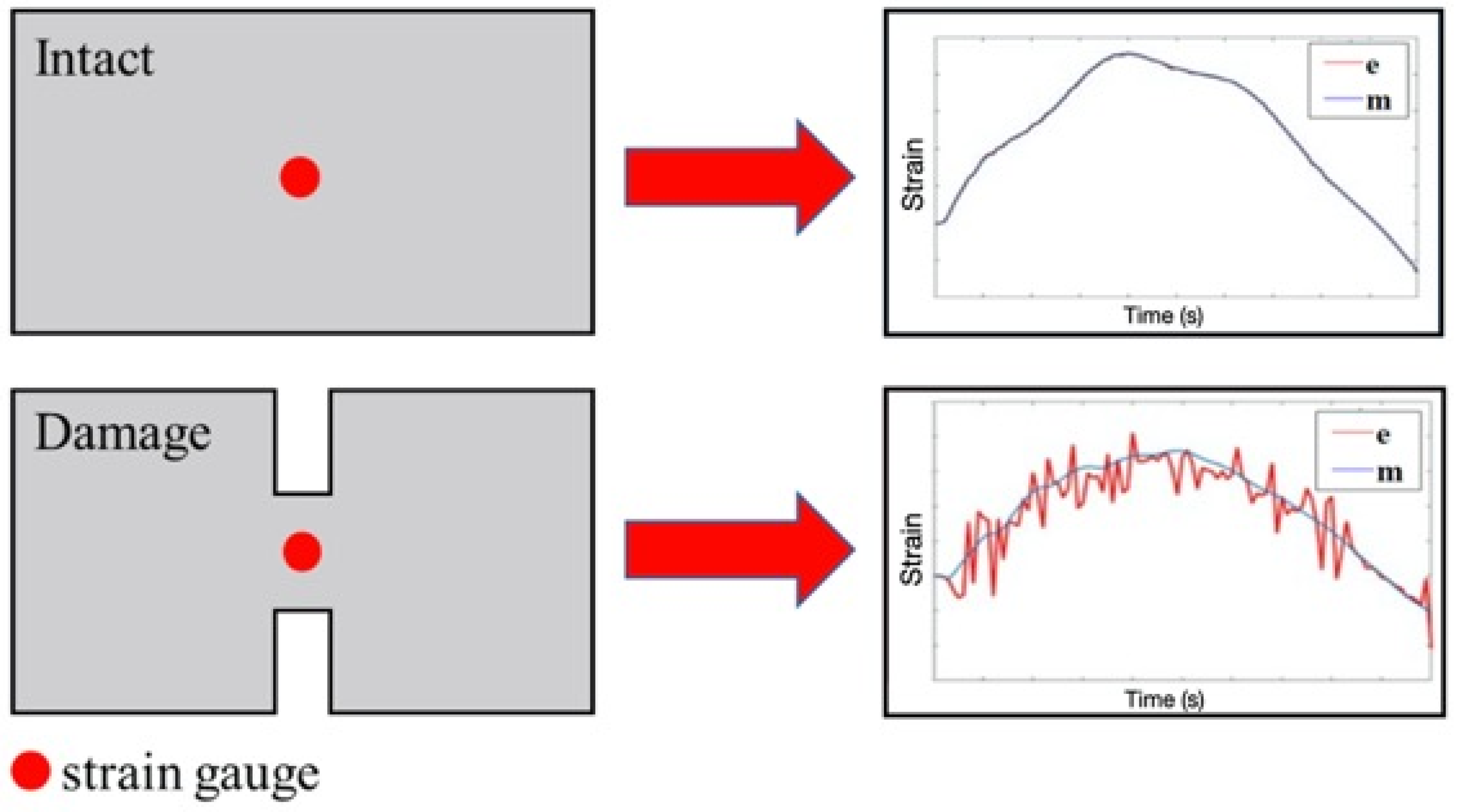
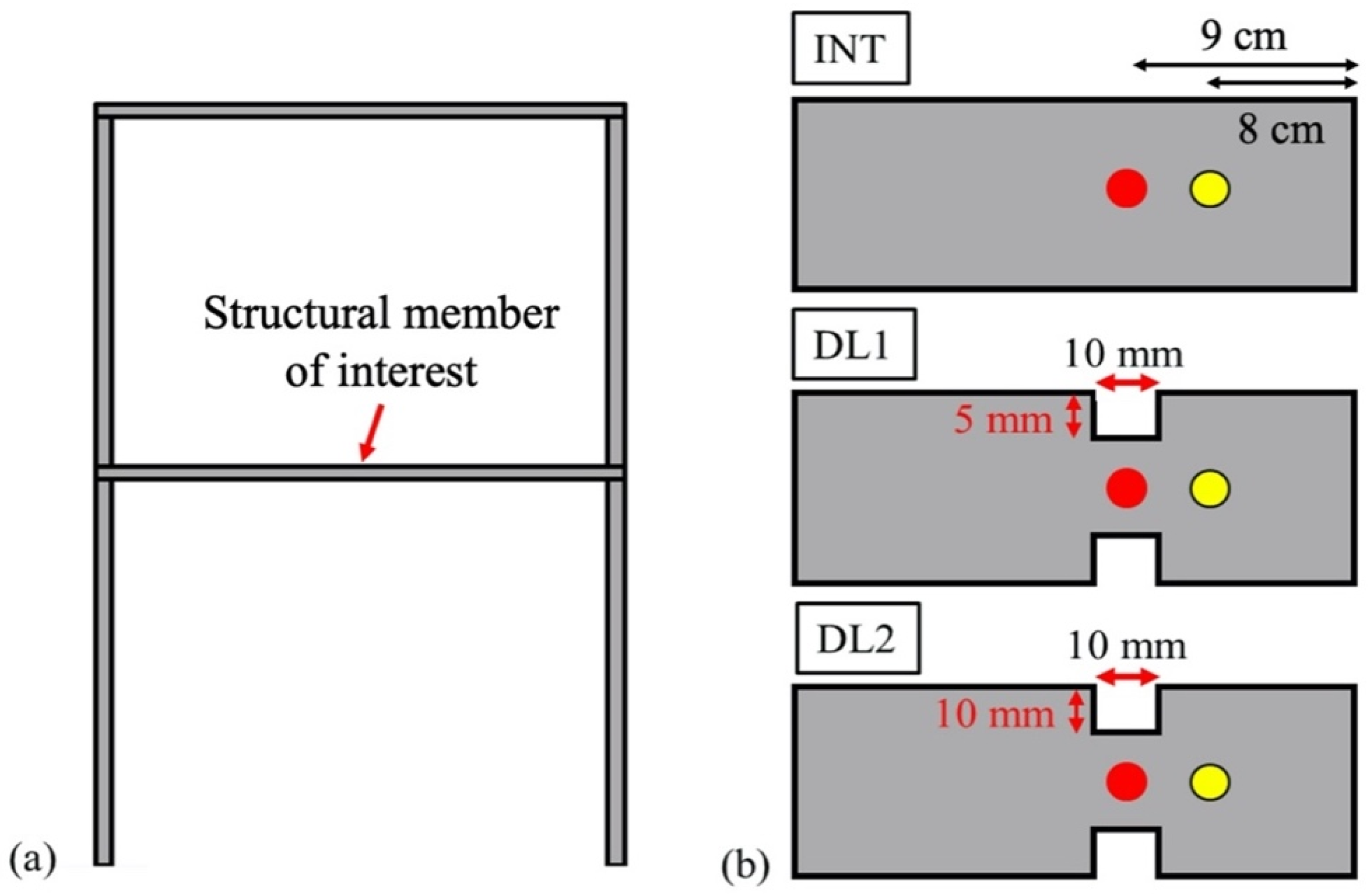
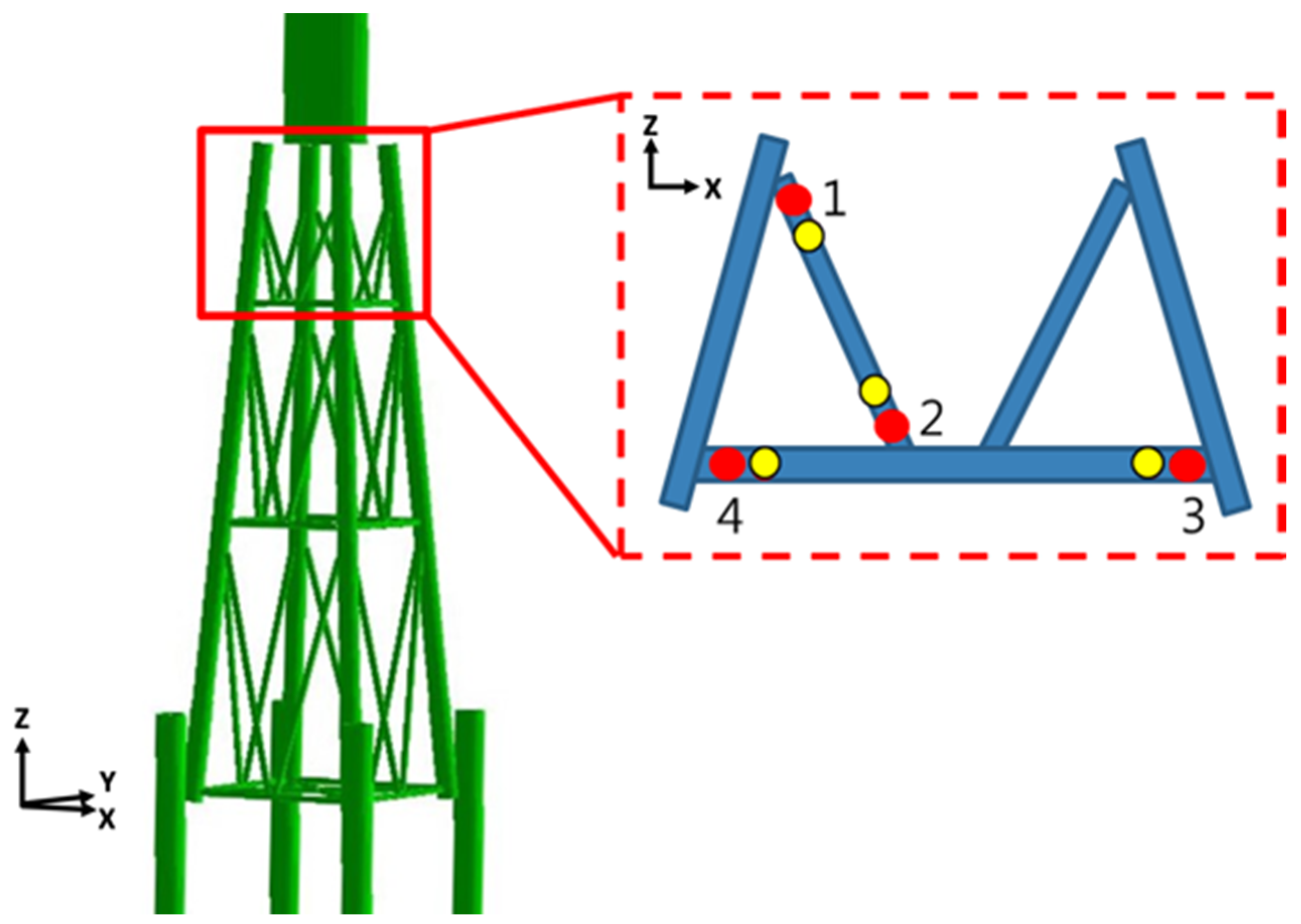
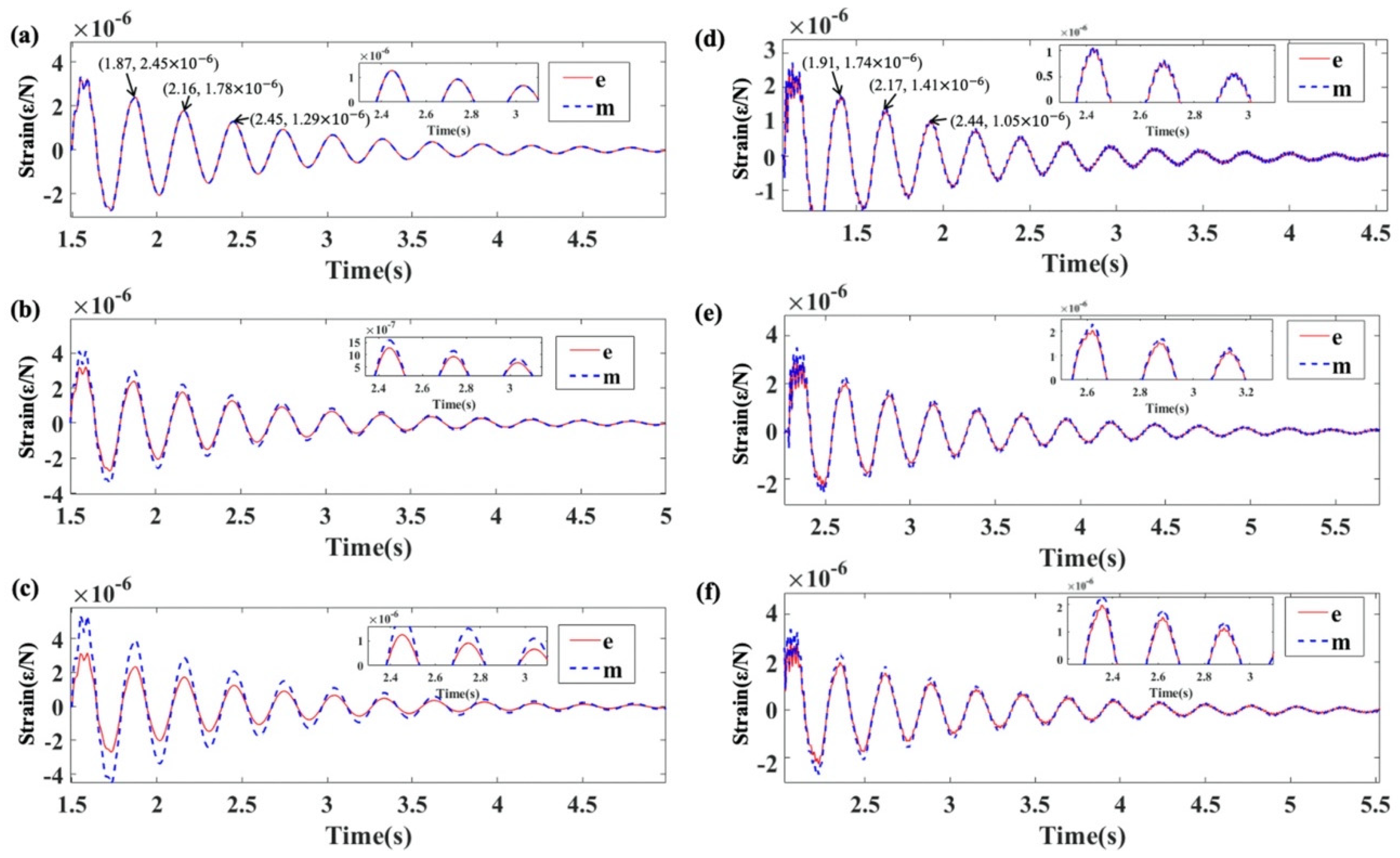
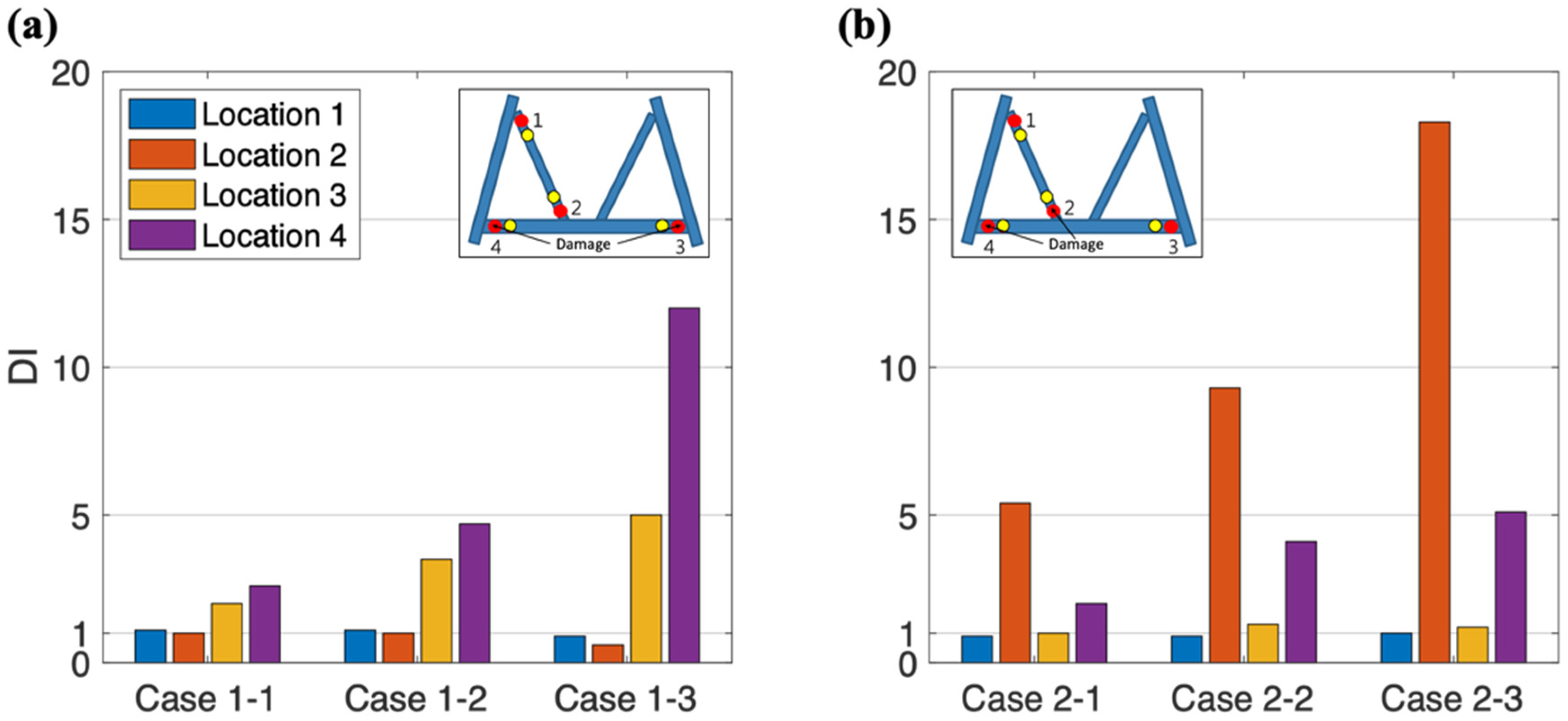
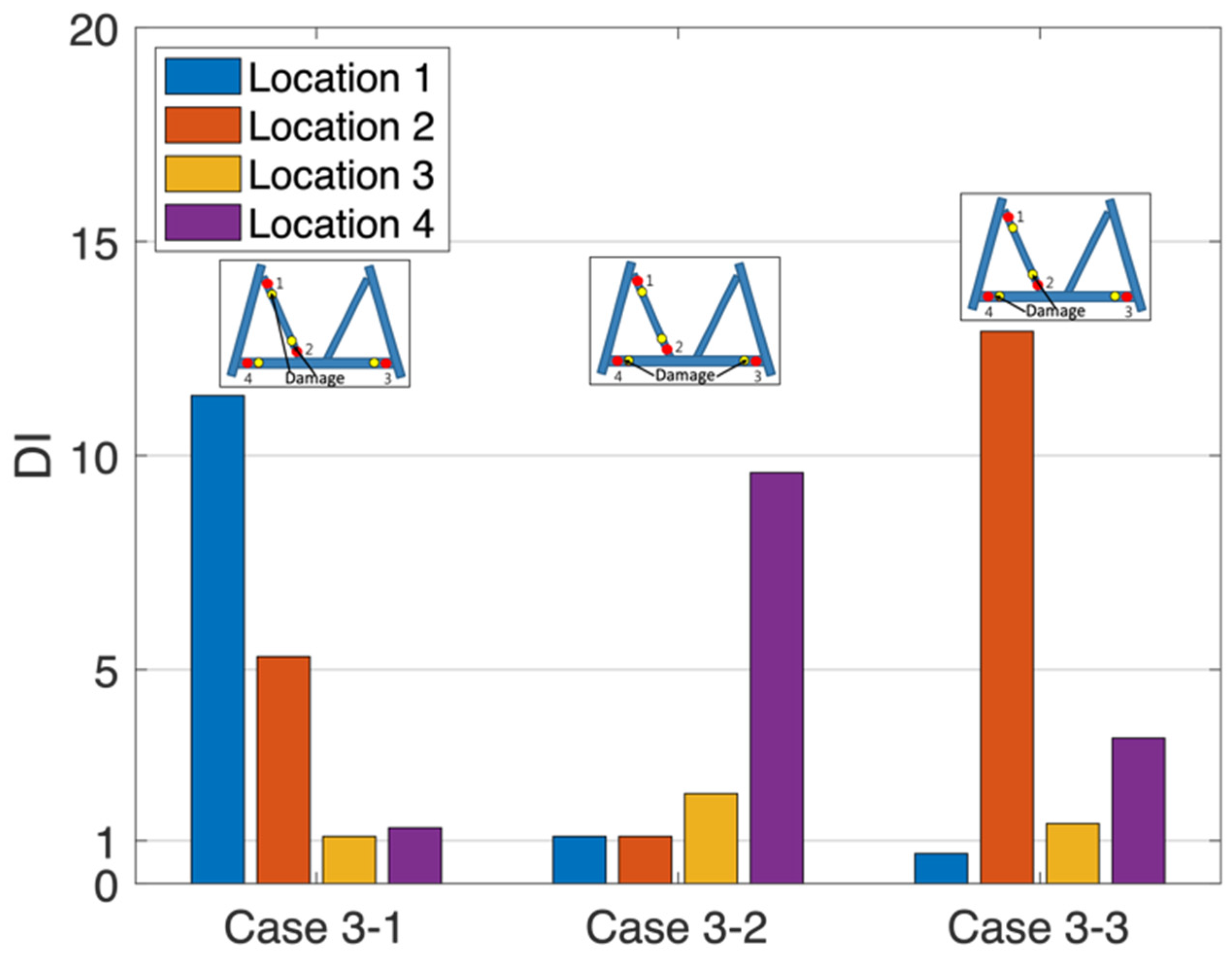
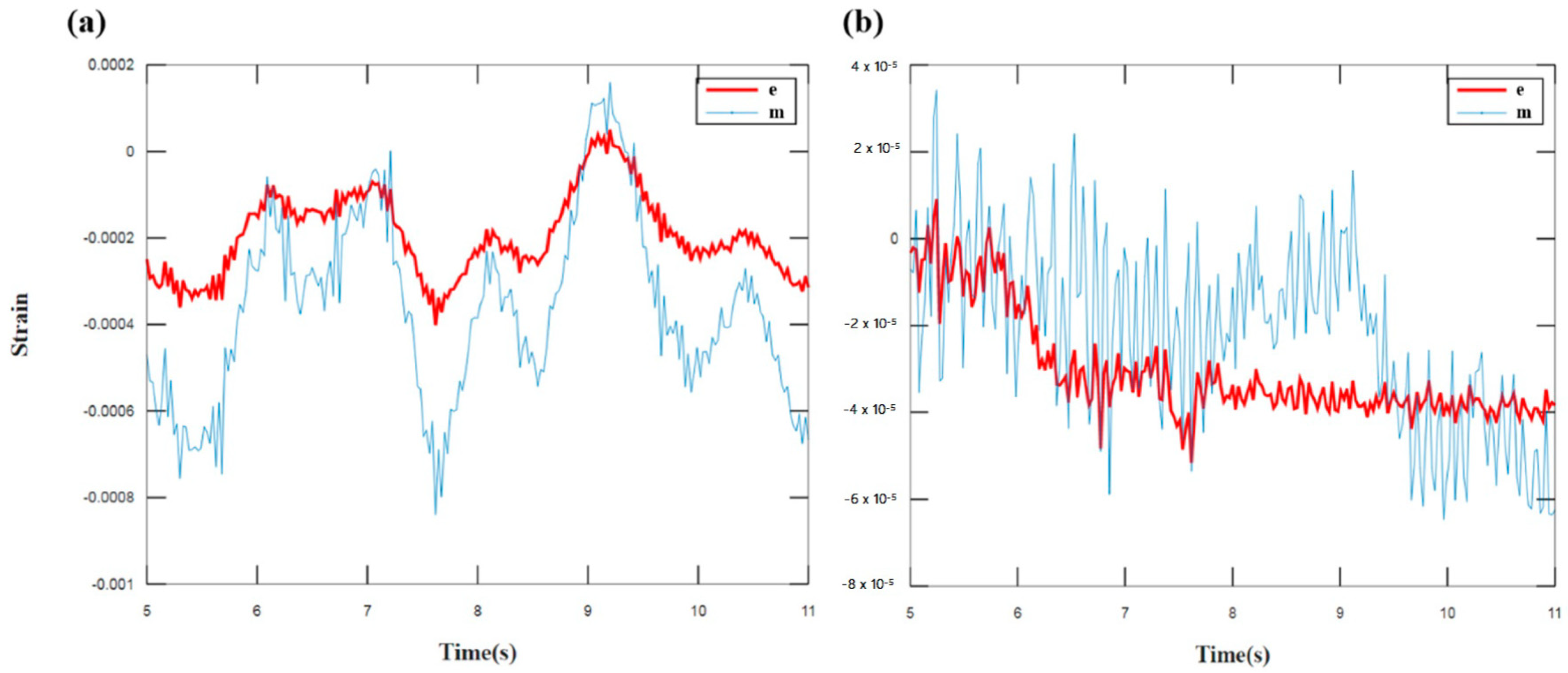
| Scenario | Description |
|---|---|
| INT | Intact pipe, 18.9 mm thickness |
| DL1 | Minor damage, 79.4% thickness |
| DL2 | Moderate damage, 63.5% thickness |
| DL3 | Severe damage, 52.9% thickness |
| Location 1 | Location 2 | Location 3 | Location 4 | |
|---|---|---|---|---|
| Case 1-1 | Intact | Intact | Minor damage | Minor damage |
| Case 1-2 | Intact | Intact | Moderate damage | Moderate damage |
| Case 1-3 | Intact | Intact | Severe damage | Severe damage |
| Case 2-1 | Intact | Minor damage | Intact | Minor damage |
| Case 2-2 | Intact | Moderate damage | Intact | Moderate damage |
| Case 2-3 | Intact | Severe damage | Intact | Severe damage |
| Case 3-1 | Severe damage | Minor damage | Intact | Intact |
| Case 3-2 | Intact | Intact | Minor damage | Severe damage |
| Case 3-3 | Intact | Severe damage | Intact | Minor damage |
Publisher’s Note: MDPI stays neutral with regard to jurisdictional claims in published maps and institutional affiliations. |
© 2020 by the authors. Licensee MDPI, Basel, Switzerland. This article is an open access article distributed under the terms and conditions of the Creative Commons Attribution (CC BY) license (http://creativecommons.org/licenses/by/4.0/).
Share and Cite
He, J.-H.; Liu, D.-P.; Chung, C.-H.; Huang, H.-H. Identification of Multiple Local Damage to an Offshore Jacket Substructure Using a Novel Strain Expansion–Reduction Approach. Appl. Sci. 2020, 10, 7991. https://doi.org/10.3390/app10227991
He J-H, Liu D-P, Chung C-H, Huang H-H. Identification of Multiple Local Damage to an Offshore Jacket Substructure Using a Novel Strain Expansion–Reduction Approach. Applied Sciences. 2020; 10(22):7991. https://doi.org/10.3390/app10227991
Chicago/Turabian StyleHe, Jia-Hao, Ding-Peng Liu, Cheng-Hsien Chung, and Hsin-Haou Huang. 2020. "Identification of Multiple Local Damage to an Offshore Jacket Substructure Using a Novel Strain Expansion–Reduction Approach" Applied Sciences 10, no. 22: 7991. https://doi.org/10.3390/app10227991
APA StyleHe, J.-H., Liu, D.-P., Chung, C.-H., & Huang, H.-H. (2020). Identification of Multiple Local Damage to an Offshore Jacket Substructure Using a Novel Strain Expansion–Reduction Approach. Applied Sciences, 10(22), 7991. https://doi.org/10.3390/app10227991






